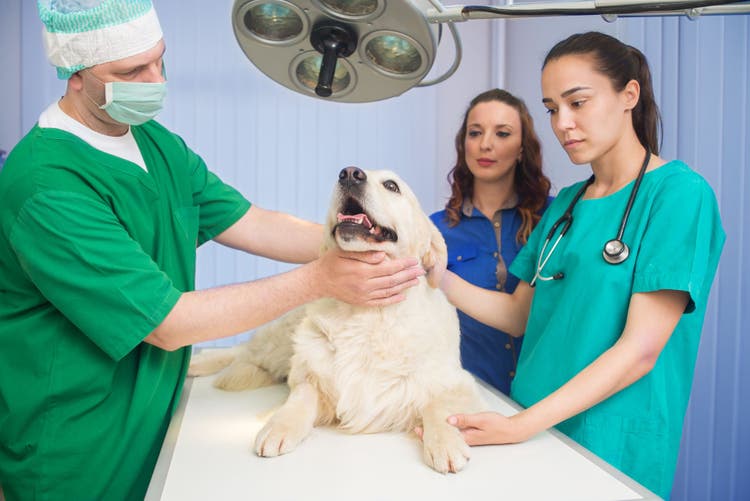
Fatty Cysts in Dogs
Pet parents common ask questions about fatty cysts in dogs. Fatty Tumors, also known as lipomas or fatty cysts, are amongst the most common tumors that occur in dogs. Most fatty tumors are under the skin, in a space referred to as the subcutaneous space, which lies between the skin and muscle. The skin over the mass is generally normal in appearance.
Fatty tumors are generally soft although can be firm if they develop under deeper tissue layers. They can be movable or attached and are generally round in shape. Fatty tumors can vary in size but can grow to become very large. Some can be the size of an egg and others as big as a basketball. Some fatty tumors can be over 14 pounds in weight when surgically removed. Fatty tumors generally grow slowly. Dogs that tend to get one fatty tumor will tend to get more as they age.
Figure legend: Fatty cyst from a dog. This fatty cyst, also known as a fatty tumor or lipoma, was surgically removed from the body wall of an 8-year-old Labrador Retriever. This fatty cyst weighed 8 ½ pounds.
Fatty tumors are most common in middle-aged to older dogs. Fatty tumors can occur anywhere on the body but are most common on the chest and abdominal walls, legs, and armpits (axillae). They are more common in overweight dogs and occur about twice as often in female as compared to male dogs. They can occur in any breed but are most common in Labrador Retrievers, cocker spaniels, dachshunds, Weimaraners, miniature schnauzers and Doberman pinschers. Lipomas can also occur in cats but are much less frequent.
How to Determine if the Mass on Your Dog is a Fatty Cyst
If your dog has a lump or mass, the best way to help determine the underlying cause is a fatty cyst to see your veterinarian. They have the experience to help you identify the type of tumor and provide recommendations for treatment or additional care. Your veterinarian may provide the following:
A complete examination. Your vet will look at your dog’s eyes, ears, listen to the heart and lungs, and feel the abdomen to evaluate the size and shape of the kidneys, spleen, intestines, bladder, and liver.
- Examine the skin lump. Your vet will evaluate the skin mass noting the size, shape, depth, consistency, location, color, and more. They will also feel for additional lumps, which can be common in some dogs that develop fatty tumors. Most fatty tumors develop around the neck or over the body wall such as the rib cage or abdomen but can occur anywhere on the body. The skin over the lump is generally completely normal without any sign of infection or pigmentation.
- Provide recommendations. Based on the location of the tumor, size, ulcerations, and signs of infections, your vet will provide a recommendation as to the best approach to the fatty cyst. They may recommend to evaluate the mass with a Fine needle aspirate (FNA), Biopsy, or recommend mass removal (often called “lumpectomy”). Most times a fine needle aspiration can diagnose a fatty cyst on a dog.
Treatment of Fatty Cysts on Your Dog
No treatment is required for most fatty cysts. Fatty tumors are not malignant but can grow so large that they interfere with function or can break open and become infected. For example, they can occur in the armpit causing difficulty in a dogs ability to walk. Some tumors can occur on the abdomen or chest way making it uncomfortable for a dog to lie down. Other tumors can become ulcerated and infected. In these cases, surgical removal is recommended to optimize comfort.
Figure legend: This fatty cyst was surgically removed and is sitting on the surgery table on the left. As you can see, it looks like a big ball of fat. This fatty cyst was removed from the right inguinal region in this 10-year-old Golden retriever. It was interfering with how this dog was walking and therefore was removed.
Other Types of Cysts
Some pet owners may confuse a fatty tumor with a sebaceous cyst. A sebaceous cyst is a small sac containing an accumulation of secretions produced by the sebaceous glands. They can appear as small bumps that break open and drain a thick white to yellow cheesy substance. Some pet owners may believe this cyst is “fatty” and refer to this as a fatty cyst. Sebaceous cysts are generally small – less than 1 inch in size. For more information – please read sebaceous cysts in dogs.
Other Causes of Large Bumps on Dogs
There are several additional causes of large bumps on dogs besides fatty tumors. Other large bumps in dogs may include:
- Ear Tumors
- Mammary Gland Tumors
- Testicular Tumors in Dogs
- Lymph node cancer – Lymphoma in Dogs
Small Bumps on Your Dog
Some fatty tumors on dogs are small but many can grow to be very large. Learn more about What Small Bumps on Dogs Can Mean?
Common small tumors include Skin Tags, Canine Viral Papillomas (Dog Warts), Mast Cell Tumor, Melanomas, and Histiocytomas. Learn more about lumps that are pigmented with this article What Does a Black Lump on a Dog’s Skin Mean?
We hope this article helps you better understand the causes of some fatty cysts in dogs.
Additional Articles of Interest Relating to Lumps on Dogs:
- I Found a Hard Lump on My Dog — What is it?
- What Large Bumps on Dogs Can Mean
- What Does a Black Lump on a Dog’s Skin Mean?
- Canine Cancer – What Are the Warning Signs?
- Transmissible Venereal Tumor in Dogs
- Metastatic Neoplasia (Cancer) in Dogs
- Lipoma (Fatty Tumor) in Dogs
- Skin Cancer in Dogs
- Lumpectomy in Dogs